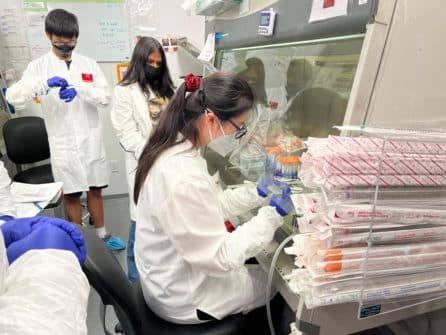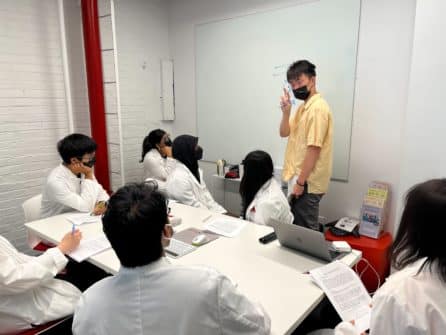High School Students Join NYSCF for a Week of Immersive Stem Cell Education
NewsScience is much more than textbooks and lectures: it’s dynamic, interdisciplinary, and hands-on. For the past three summers, NYSCF has brought talented young minds together for our Stem Cell Research Immersive for High School Students. This annual program is part of NYSCF’s commitment to democratizing access to STEM education by providing opportunities to students who may not have otherwise been able to engage with the latest in biomedical research and discovery. Through this immersive experience, students have the opportunity to speak with scientists, dive into current topics in research, build professional skills, and even step foot in the lab themselves for a day of scientific exploration.
“As an advocate for more diversity in STEM careers, I am so grateful to help lead this special experience for these bright young scientists, including students from my own school!” noted Josh Modeste, a science teacher at the Urban Assembly School for Global Commerce who helped lead the immersive. “The nature of the NYSCF mission and the diversity of the staff and scientists makes this truly a unique program that many students would not have access to otherwise. It is so exciting to see students connect with scientists they can relate to and how it inspires so many students to pursue STEM majors, internships, and careers.”
A Day in the Life of a Scientist
After two years of fully virtual programming, students this year were invited to visit the laboratories at the NYSCF Research Institute where they learned about how NYSCF conducts research using our robotic system, The NYSCF Global Stem Cell Array®, and practiced foundational lab skills (pipetting is harder than you think!).
NYSCF scientists taught the students about different aspects of research: imaging, quality control, and everything in between, and students were encouraged to ask questions about the research process and the life of a scientist.

“I found working in a tissue culture hood so interesting,” remarked one student. “I never thought I’d be able to do that in high school.”
“I really liked being able to try a bunch of different things in the lab,” agreed another. “It introduced me to a wide range of skills that I think will be very useful in my future.”
“It was so cool to interact with the things that you normally only learn about online and at school,” a student added. “Plus the mentors were really great at guiding me.”
Deep Dives into Hot Topics in Stem Cell Research
The Immersive began with virtual programming including a crash course in stem cells from NYSCF Senior Vice President of Discovery & Platform Development Daniel Paull, PhD.
“Stem cells are incredibly valuable for research because they can infinitely self replicate, and we can turn them into any cell type in the body,” he explained. “This way, we can create the actual cells affected by a disease from patients themselves, providing a window into how the cells malfunction and how we may be able to fix them.”
This is exactly how NYSCF Senior Research Investigator Valentina Fossati, PhD, uses stem cells to study neurodegenerative diseases like multiple sclerosis and Alzheimer’s. Dr. Fossati stopped by to chat all about this work and what it means for the future of treatments.
“Neurodegenerative diseases are among the hardest to treat, and we cannot treat what we don’t understand,” she said.
Dr. Fossati uses stem cells to create all the cell types of the brain, teasing apart how each plays a role in disease.
“The brain is a bit like an orchestra – there are many different kinds of cells that must act like instruments to create a perfect harmony, and if one is out of tune, things can start to fall apart. Stem cells can help us pinpoint why a cell goes awry, and point to opportunities to get it back in tune.”

One major scientific breakthrough in recent years is the development of advanced gene editing strategies that can allow researchers to explore how someone’s genetics impact their disease risk and severity.
“With gene editing, we can try to figure out why a gene is important for a specific function in the body or how a mutation can lead to disease,” explained Josi Wesely, PhD, Principal Scientist in Functional Genomics. “We can do this for different cell types created from stem cells, helping illuminate the link between genes and disease.”
“It was really cool to hear from a gene editing expert about the field because I’m super interested in that topic and she shared a lot of stuff I didn’t know about,” said one student.
Building Skills for Professional Success
Apart from delving into the science of stem cells, students also attended workshops and panels aimed at fostering other professional skills, exploring careers in STEM, and promoting diversity, equity, inclusion, and belonging (DEIB).
In a workshop led by Sandra Capellera-Garcia, PhD, students learned strategies for communicating about science for a variety of audiences.
“Science communication is incredibly important for many reasons,” she explained. “All the research we do is useless if no one knows about it. Every funding source we have depends on effective communication, and how we speak and write about what we do can even spark new collaborations and establish ourselves as leaders in the field, allowing us to keep doing impactful science.”
NYSCF Vice President of Scientific Outreach & DEIB Raeka Aiyar, PhD, walked students through strategies to combat racial health disparities and foster DEIB in the STEM community.
“Collaboration is super important for fostering DEIB, because we cannot do this important work alone,” she noted. “As you progress in your careers, look for others who are interested in this work and try to get involved. See how you can use your position and platform to advocate for others and keep educating yourself. Luckily we are at an inflection point in taking on systemic discrimination, and now have an opportunity to capitalize on this momentum.”
“Education is a big thing,” agreed one student. “Whether it’s in schools or the workplace, allowing room for these [DEIB-focused] discussions is really important.”
“I think it’s also really critical to highlight and celebrate the accomplishments of minorities in STEM,” added another.
Students also participated in a resume, LinkedIn profile, and interview training workshop where they learned how to make themselves stand out when applying for jobs and internships.
“I found the mock interviews very valuable,” noted one student. “It really made me think of ways I can improve my interviewing strategies and how to streamline my resume. And it really felt like a real interview with questions I’ll probably be asked for internships in the future.”
NYSCF employees from different areas of STEM also joined students for a career panel highlighting what it’s like to work in programs administration, scientific communications, engineering, legal, and research.
“I’ve always been interested in technology, and even though I didn’t have a technical background, doing legal work in the STEM field has allowed me to combine my interests and learn a lot about science and technology on the job,” remarked Corvis Richardson, JD, Associate Vice President of IP Tech Transactions & Legal Affairs.
“My favorite part of my work is the collaboration with so many different people from different backgrounds,” added Cecile Terrenoire, PhD, Senior Director of Process Development. “We have engineers, data scientists, and researchers who all work under one roof, and you can learn so much from different groups. I also love our education efforts and getting to share my passion for what I do with people such as yourselves.”
“The career panel was really helpful for learning about different careers and what STEM professionals do each day,” remarked a student.
“Hearing about everyone’s journeys and advice was super interesting and enjoyable,” agreed another.
Inspiring the Next Generation of Scientists
Altogether, students expressed that the Immersive piqued their interest in STEM and invigorated their drive to get involved in stem cell research. Every student reported that they are more likely to participate in a STEM major and a STEM career, that they learned about a new career, and that they feel more prepared for their STEM classes in school.
We were thrilled to spend the week with this talented group, and we are excited to see everything they accomplish in the future!

